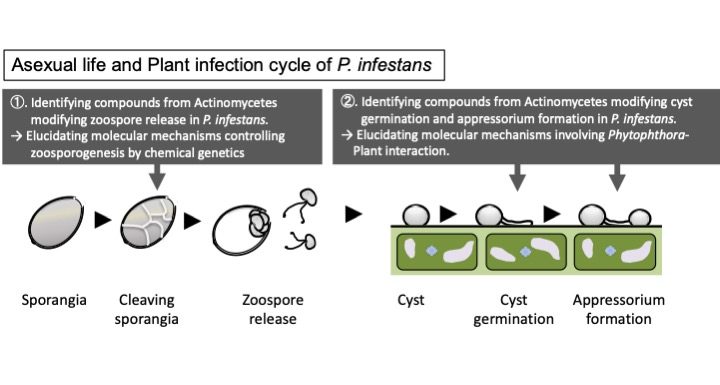Researchch
Regulation mechanisms of cellulase genes in Aspergilli
 Aspergillus includes useful species to produce Japanese traditional fermentation food, such as miso, soy sauce, and sake. This useful aspects of Aspergillus are due to the nature of this filamentous fungi that produces various useful enzymes to degrade organic matters to each component part.
Aspergillus includes useful species to produce Japanese traditional fermentation food, such as miso, soy sauce, and sake. This useful aspects of Aspergillus are due to the nature of this filamentous fungi that produces various useful enzymes to degrade organic matters to each component part.
Aspergillus aculeatus was isolated from soil as a producer of polysaccharide degrading enzymes in 1960’s in Osaka Prefecture University. This fungus secretes various types of cellulases and hemicellulases which are featured by the ability to break polysaccharides down to each component sugar. A. aculeatus is confered an unique set of the degrading enzyme genes. To utilize these genetic resources, we aim to better understand the regulation mechanisms of these enzyme genes and establish the effective and the economical way to improve their production in A. aculeatus.
We so far identified a new transcription factor, ClbR, and achieved to increase enzyme production by enhancing the expression of clbR in A. aculeatus.
Control of late blight disease
 Oomycetes, classified in the kingdom Stramenopiles, contain many economically important eukaryotic plant pathogens. The genera Phytophthora and Pythium include one of the most destructive plant pathogens, all of which cause plant disease of crops, shrubs, and trees on a global scale. Phytophthora infestans is historically and economically important plant pathogen, and which is known to infect plants in Solanaceae and causes late blight of potato and tomato. International potato center estimates that the annual economic value of crop losses from late blight caused by P. infestans reaches to approximately $3 billion.
Oomycetes, classified in the kingdom Stramenopiles, contain many economically important eukaryotic plant pathogens. The genera Phytophthora and Pythium include one of the most destructive plant pathogens, all of which cause plant disease of crops, shrubs, and trees on a global scale. Phytophthora infestans is historically and economically important plant pathogen, and which is known to infect plants in Solanaceae and causes late blight of potato and tomato. International potato center estimates that the annual economic value of crop losses from late blight caused by P. infestans reaches to approximately $3 billion.
P. infestans produce asexual sporangia that exhibit dual modes of germination when placed in liquid. Above 15˚C, germ tubes typically emerge directly from sporangia. However, at lower temperatures the cytoplasm of sporangia is conditioned to cleave into six or more uninucleate biflagellated zoospores. Germination through zoospores can occur in less than an hour. The contribution of zoospores to disease is believed to be higher than that of directly geminating sporangia. We are studying molecular mechanisms how Phytophthora perceives temperatures and trigger sporangium development.